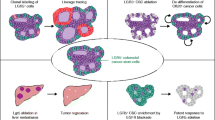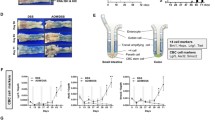Abstract
The identification and separation of small intestinal epithelial stem cells are still on the preliminary stage. In this study, we planned to utilize immunohistochemistry, fluorescence-activated cell sorting (FACS) and RT-PCR to investigate the possibility of CD133 and CD44 as markers of human small intestinal epithelial stem cells. The expressions of CD133, CD44 and Lgr5 were studied by immunohistochemistry. Four subgroups of CD133+CD44+, CD133+CD44−, CD133−CD44+, CD133−CD44− were sorted out through FACS and the expression level of Lgr5 gene was measured by RT-PCR and polyacrylamide gel electropheresis (PAGE) with sliver stained. Ten cases of samples were available for analyzing. By immunohistochemical staining, few cells with positive expressions of CD133, CD44 and Lgr5 were distributed in the bottom of crypts with the expression locations somewhat overlapped. The average percentage of CD133+CD44+ cells was 0.0580 ± 0.0403%, while the corresponding contents of CD133+CD44− cells, CD133−CD44+ cells and CD133−CD44− cells were 0.4000 ± 0.1225%, 0.7000 ± 0.2646% and 76.5600 ± 3.5529% respectively. Ten times of positive expressions of Lgr5 were detected in the CD133+CD44+ groups, while 9/10, 8/10 and 4/10 times for CD133+CD44−, CD133−CD44+ and CD133−CD44− subgroups respectively. With the help of Quantityone 4.62 software, the densities of corresponding place to Lgr5 and reference gene were obtained. The density ratios of corresponding place to Lgr5 to reference gene were significant difference between subgroups (P < 0.001). By means of LSD method, the density ratios in CD133+CD44+ subgroups had statistical differences from the other subgroups (P < 0.05). We concluded CD133+CD44+ cells may be human small intestinal epithelial stem cells, which need further researches to confirm.




Similar content being viewed by others
References
Cheng H, Leblond CP (1974) Origin, differentiation and renewal of the four main epithelial cell types in themouse small intestine. V. Unitarian theory of the origin of the four epithelial cell types. Am J Anat 141:537–561
Ponder BA, Schmidt GH, Wilkinson MM, Wood MJ, Monk M, Reid A (1985) Derivation of mouse intestinal crypts from single progenitor cells. Nature 313:689–691
Loeffler M, Roeder I (2002) Tissue stem cells: Definition, plasticity, heterogeneity, self-organization and models - a conceptual approach. Cells Tissues Organs 171:8–26
Potten CS (2004) Radiation, the ideal cytotoxic agent for studying the cell biology of tissues such as the small intestine. Radiat Res 161:123–136
Montgomery RK, Breault DT (2008) Small intestinal stem cell markers. J Anat 213:52–58
Potten CS, Booth C, Tudor GL, Booth D, Brady G, Hurley P, Ashton G, Clarke R, Sakakibara S, Okano H (2003) Identification of a putative intestinal stem cell and early lineage marker; musashi-1. Differentiation 71:28–41
Kayahara T, Sawada M, Takaishi S, Fukui H, Seno H, Fukuzawa H, Suzuki K, Hiai H, Kageyama R, Okano H, Chiba T (2003) Candidate markers for stem and early progenitor cells, Musashi-1 and Hes1, are expressed in crypt base columnar cells of mouse small intestine. FEBS Lett 535:131–135
Fujimoto K, Beauchamp RD, Whitehead RH (2002) Identification and isolation of candidate human colonic clonogenic cells based on cell surface integrin expression. Gastroenterology 123:1941–1948
Hsu SY, Liang SG, Hsueh AJ (1998) Characterization of two LGR genes homologous to gonadotropin and thyrotropin receptors with extracellular leucine-rich repeats and a G protein-coupled, seven-transmembrane region. Mol Endocrinol 12:1830–1845
Barker N, van Es JH, Kuipers J, Kujala P, van den Born M, Cozijnsen M, Haegebarth A, Korving J, Begthel H, Peters PJ, Clevers H (2007) Identification of stem cells in small intestine and colon by marker gene Lgr5. Nature 449:1003–1007
Becker L, Huang Q, Mashimo H (2008) Immunostaining of Lgr5, an intestinal stem cell marker, in normal and premalignant human gastrointestinal tissue. ScientificWorldJournal 8:1168–1176
Weigmann A, Corbeil D, Hellwig A, Huttner WB (1997) Prominin, a novel microvilli-specific polytopic membrane protein of the apical surface of epithelial cells, is targeted to plasmalemmal protrusions of non-epithelial cells. Proc Natl Acad Sci U S A 94:12425–12430
Yin AH, Miraglia S, Zanjani ED, Almeida-Porada G, Ogawa M, Leary AG, Olweus J, Kearney J, Buck DW (1997) AC133, a novel marker for human hematopoietic stem and progenitor cells. Blood 90:5002–5012
Miraglia S, Godfrey W, Yin AH, Atkins K, Warnke R, Holden JT, Bray RA, Waller EK, Buck DW (1997) A novel five-transmembrane hematopoietic stem cell antigen: isolation, characterization, and molecular cloning. Blood 90:5013–5021
Mizrak D, Brittan M, Alison MR (2008) CD133: molecule of the moment. J Pathol 214:3–9
Zhu L, Gibson P, Currle DS, Tong Y, Richardson RJ, Bayazitov IT, Poppleton H, Zakharenko S, Ellison DW, Gilbertson RJ (2009) Prominin 1 marks intestinal stem cells that are susceptible to neoplastic transformation. Nature 457:603–607
O’Brien CA, Pollett A, Gallinger S, Dick JE (2007) A human colon cancer cell capable of initiating tumour growth in immunodeficient mice. Nature 445:106–110
Ricci-Vitiani L, Lombardi DG, Pilozzi E, Biffoni M, Todaro M, Peschle C, De Maria R (2007) Identification and expansion of human colon-cancer-initiating cells. Nature 445:111–115
Piccirillo SG, Reynolds BA, Zanetti N, Lamorte G, Binda E, Broggi G, Brem H, Olivi A, Dimeco F, Vescovi AL (2006) Bone morphogenetic proteins inhibit the tumorigenic potential of human brain tumour-initiating cells. Nature 444:761–765
Suetsugu A, Nagaki M, Aoki H, Motohashi T, Kunisada T, Moriwaki H (2006) Characterization of CD133 + hepatocellular carcinoma cells as cancer stem/progenitor cells. Biochem Biophys Res Commun 351:820–824
Yin S, Li J, Hu C, Chen X, Yao M, Yan M, Jiang G, Ge C, Xie H, Wan D, Yang S, Zheng S, Gu J (2007) CD133 positive hepatocellular carcinoma cells possess high capacity for tumorigenicity. Int J Cancer 120:1444–1450
Vercauteren SM, Sutherland HJ (2001) CD133 (AC133) expression on AML cells and progenitors. Cytotherapy 3:449–459
Florek M, Haase M, Marzesco AM, Freund D, Ehninger G, Huttner WB, Corbeil D (2005) Prominin-1/CD133, a neural and hematopoietic stem cell marker, is expressed in adult human differentiated cells and certain types of kidney cancer. Cell Tissue Res 319:15–26
Richardson GD, Robson CN, Lang SH, Neal DE, Maitland NJ, Collins AT (2004) CD133, a novel marker for human prostatic epithelial stem cells. J Cell Sci 117:3539–3545
Sneath RJ, Mangham DC (2000) CD44 isoform expression in synovial sarcoma correlates with epitheliogenesis but not prognosis. Histopathology 37:166–174
Al-Hajj M, Wicha MS, Benito-Hernandez A, Morrison SJ, Clarke MF (2003) Prospective identification of tumorigenic breast cancer cells. Proc Natl Acad Sci U S A 100:3983–3988
Li C, Heidt DG, Dalerba P, Burant CF, Zhang L, Adsay V, Wicha M, Clarke MF, Simeone DM (2007) Identification of pancreatic cancer stem cells. Cancer Res 67:1030–1037
Prince ME, Sivanandan R, Kaczorowski A, Wolf GT, Kaplan MJ, Dalerba P, Weissman IL, Clarke MF, Ailles LE (2007) Identification of a subpopulation of cells with cancer stem cellproperties in head and neck squamous cell carcinoma. Proc Natl Acad Sci U S A 104:973–978
Collins AT, Berry PA, Hyde C, Stower MJ, Maitland NJ (2005) Prospectiveidentification of tumorigenic prostate cancer stem cells. Cancer Res 65:10946–10951
Dalerba P, Dylla SJ, Park IK, Liu R, Wang X, Cho RW, Hoey T, Gurney A, Huang EH, Simeone DM, Shelton AA, Parmiani G, Castelli C, Clarke MF (2007) Phenotypic characterization of human colorectal cancer stem cells. Proc Natl Acad Sci U S A 104:10158–10163
Haraguchi N, Ohkuma M, Sakashita H, Matsuzaki S, Tanaka F, Mimori K, Kamohara Y, Inoue H, Mori M (2008) CD133 + CD44 + population efficiently enriches colon cancer initiating cells. Ann Surg Oncol 15:2927–2933
Du L, Wang H, He L, Zhang J, Ni B, Wang X, Jin H, Cahuzac N, Mehrpour M, Lu Y, Chen Q (2008) CD44 is of functional importance for colorectal cancer stem cells. Clin Cancer Res 14:6751–6760
Greene FL, Page DL, Fleming ID, Shah J, Winchester DP (2002) AJCC Cancer Staging Manual, 6th edn. Springer-Verlag, New York
Zhang Q, Lin G, Gu Y, Peng J, Nie Z, Huang Y, Lu G (2009) Borealin is differentially expressed in ES cells and is essential for the early development of embryonic cells. Mol Biol Rep 36:603–609
Chung N, Jee BK, Chae SW, Jeon YW, Lee KH, Rha HK (2009) HOX gene analysis of endothelial cell differentiation in human bone marrow-derived mesenchymal stem cells. Mol Biol Rep 36:227–235
Shakhbazau A, Shcharbin D, Seviaryn I, Goncharova N, Kosmacheva S, Potapnev M, Gabara B, Ionov M, Bryszewska M (2010) Use of polyamidoamine dendrimers to engineer BDNF-producing human mesenchymal stem cells. Mol Biol Rep 37:2003–2008
Haegebarth A, Clevers H (2009) Wnt signaling, lgr5, and stem cells in the intestine and skin. Am J Pathol 174:715–721
Jaks V, Barker N, Kasper M, van Es JH, Snippert HJ, Clevers H, Toftgård R (2008) Lgr5 marks cycling, yet long-lived, hair follicle stem cells. Nat Genet 40:1291–1299
Sato T, Vries RG, Snippert HJ, van de Wetering M, Barker N, Stange DE, van Es JH, Abo A, Kujala P, Peters PJ, Clevers H (2009) Single Lgr5 stem cells build crypt-villus structures in without a mesenchymal niche. Nature 459:262–265
Barker N, van Es JH, Jaks V, Kasper M, Snippert H, Toftgård R, Clevers H (2008) Very long-term self-renewal of small intestine, colon, and hair follicles from cycling Lgr5 + ve stem cells. Cold Spring Harb Symp Quant Biol 73:351–356
Snippert HJ, van Es JH, van den Born M, Begthel H, Stange DE, Barker N, Clevers H (2009) Prominin-1/CD133 marks stem cells and early progenitors in mouse small intestine. Gastroenterology 136:2187–2194.e1
Potten CS, Booth C, Pritchard DM (1997) The intestinal epithelial stem cell: the mucosal governor. Int J Exp Pathol 78:219–243
Shu W, Shu YT, Shi HB, Fei LX, Lei W, Ming QG (2008) An easy method to discover cell membrane antigen with atomic force microscopy. Mol Biol Rep 35:557–561
Geens M, Van de Velde H, De Block G, Goossens E, Van Steirteghem A, Tournaye H (2007) The efficiency of magnetic-activated cell sorting and fluorescence-activated cell sorting in the decontamination of testicular cell suspensions in cancer patients. Hum Reprod 22:733–742
Fejes-Tóth G, Náray-Fejes-Tóth A (1991) Fluorescence activated cell sorting of principal and intercalated cells of the renal collecting duct. J Tiss Cult Meth 13:173–178
Acknowledgements
This study was granted by National Natural Science Foundation of China (No. 30600591). The authors thank Dr Ashok Kunwar (Department of Urology, West China Hospital, Sichuan University, P.R.China) for his diligent checking of the manuscript.
Conflicts of interest
None to declare.
Author information
Authors and Affiliations
Corresponding author
Rights and permissions
About this article
Cite this article
Hou, NY., Yang, K., Chen, T. et al. CD133+CD44+ subgroups may be human small intestinal stem cells. Mol Biol Rep 38, 997–1004 (2011). https://doi.org/10.1007/s11033-010-0195-y
Received:
Accepted:
Published:
Issue Date:
DOI: https://doi.org/10.1007/s11033-010-0195-y




